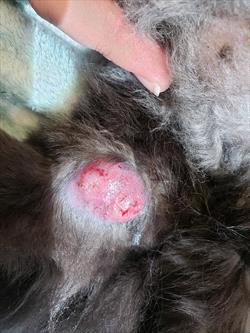Cutaneous Lymphosarcoma on Cat Hock

Photo Courtesy Dr. Margaret Henderson
Lymphoma is common in cats, but is seen in so many ways and different places that it is confusing. It can be seen in almost any organ. When it affects the skin, it is called cutaneous lymphoma.
Lymphocytes, or lymph cells, are white blood cells and part of the immune system. Lymphocytes travel throughout the body. Some lymphocytes line organs to provide immunity against infection. When the lymphocytes become malignant with cutaneous lymphoma, however, skin tumors can develop almost anywhere on the skin. Besides the haired parts of the skin, these tumors can be seen at the lip margins, the eyelids, the anus/rectum, the vulva, and the prepuce of the penis (the fold of skin covering the penis). A specific, poorly understood form of cutaneous lymphoma seems to occur near the hock, which is the ankle of a back leg. A cat can also have skin tumors and lymphoma elsewhere in the body at the same time; often it's seen in the lymph nodes, gastrointestinal tract, liver, spleen, kidneys, mouth, or nasal passages. As with non-cutaneous lymphoma in cats, each case is different.
The disease is complex and there are several forms of it. Unfortunately, there is no overall consensus from the veterinary community on what the best course of action is in any individual cat.
The cause is unknown in most cases. Feline leukemia virus and feline immunodeficiency virus can cause lymphoma in cats, but don’t seem to be involved in most cases of cutaneous lymphoma. Lymphoma in cats can rarely happen at a vaccine site, but most vaccine-associated tumors are other kinds of cancer, not lymphoma.
Cutaneous lymphoma can look like skin nodules, masses, ulcers, or just areas of skin that are flaky, bald, or changed in color. Some of the skin tumors can be large. As time goes on, the skin often becomes thick, red, ulcerated, and may ooze fluid. Cats can also have signs of internal disease such as swollen lymph nodes, a lack of appetite, weight loss, vomiting, diarrhea, and general weakness.
For diagnosis, a piece of tissue is taken from the skin tumor, usually with either a biopsy or a fine needle aspirate. It is examined under the microscope. Cutaneous lymphoma can look like some other skin diseases, so enough testing must be done to ensure accuracy. Blood tests and a urinalysis may be needed. More tests like X-rays, ultrasound, or tissue samples may be used to see if other organs besides the skin are involved.
Treatment is much like other cancers. Surgery can sometimes remove skin masses or lesions. This surgery can be useful to get tissue to make the diagnosis. If the cat is lucky and the lymphoma is ONLY at one place on the skin, surgery may also help for treatment, but this situation is rare. It’s much more common for lymphoma to involve lots of different organs at once. Even if only the skin is affected, there are usually too many sites for surgery to help. Chemotherapy is the main form of treatment for that reason as it can help multiple areas of the body at once. If all goes well, it can be really effective at reducing the lesions even in a short time, although this result may not last. Radiation may occasionally be helpful for skin lesions occurring in just one spot. Rarely, cases with lymphoma in multiple spots on the skin have also been treated with a superficial form of radiation that treats the skin without affecting deeper organs. Corticosteroids pills such as prednisolone are often part of chemotherapy for cutaneous lymphoma. If the corticosteroids are used by themselves when more effective therapy isn’t an option, they may give some temporary relief.
Sadly, there is no cure and the long-term prognosis is poor. However, chemotherapy can slow progression and temporarily improve a cat’s quality of life. On average, cats treated for cutaneous lymphoma will only survive for less than a year. Some cats live longer, though, and cats whose disease starts out at only one spot might be likely to do better.